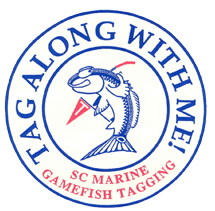Marine - Species
Red Drum (Sciaenops ocellatus)
General Description
Iridescent silver-gray with a copper cast, darker above; one or more oscillated spots on upper sides from below soft portion of dorsal fin to base of caudal fin. Mouth inferior and horizontal, teeth set in bands on both jaws. Chin without barbels, smooth pre-opercular margin.
Average Size
18 inches, 2.6 pounds;
South Carolina State Record: 75 pounds (1965);
maximum age: approx. 38 years (a few individuals as old as 60 have been reported in other states).
Habitat
Adults: Utilize nearshore and inshore bottom habitats, such as tidal creeks, oyster reefs, and beaches, typically over sandy or sandy-mud bottoms; may also congregate in nearshore groups.
Juveniles: Inhabit estuaries near shallow tidal creeks and salt marshes, commonly at marsh grass edges or in the vicinity of oyster reefs; reside in deeper river channels during winter. Subadults inhabit larger tidal creeks, rivers, and the front beaches of barrier islands.
Reproductive Cycle
- Adults mature by 3 – 5 years of age; approximate length at maturity: males – 28 inches, females – 33 inches.
- Spawn during late summer and fall. Spawning aggregations occur near estuary inlets and passes along barrier island beaches. Males produce drumming sounds using muscular contractions to vibrate the swimbladder, to attract females.
- Larval red drum use vertical migrations to ride high salinity tidal currents into tidal creeks and shallow salt marsh nursery habitats.
Foraging Habits
- All sizes of red drum are predatory foragers on or near the bottom; inshore foraging (juveniles) typically occurs at marsh grass edges.
- Adults: Feed primarily on menhaden, spot, anchovies, blue crab, and speckled crab.
- Juveniles: Feed on opossum shrimp, grass shrimp, juvenile spot, and mud minnows, mud crabs, and fiddler crabs. Subadult diet is similar to adult fish. Larvae feed primarily on zooplankton and small invertebrates.
Availability/Vulnerability to Harvest
- Present in South Carolina waters year-round. Distribution is predominantly temperature dependent: juvenile fish progress from marshes and tidal creeks to overwinter in deeper inshore waters; larger adults overwinter offshore and return to nearshore waters during spring.
- No commercial red drum fishery currently exists in South Carolina; potential for recreational harvest is significant since legal size fish inhabit inshore and nearshore waters during a large portion of the year.
- Conservation concerns: degradation and loss of estuarine habitats; lack of information on South Carolina spawning locations; maintenance of optimal numbers of subadult and spawning size fish.
Literature Cited
ASMFC. 2002. Amendment 2 to the interstate fishery management plan for red drum. Fishery Management Report No. 38, Atlantic States Marine Fisheries Commission, Washington D.C. 142 pp.
Fischer W. 1978. FAO identification sheets for fisheries purposes: western central Atlantic (fishing area 31) volume 1 – 7. Food and Agriculture Organization of the United Nations, Rome.
Goldstein RJ. 2000. Coastal fishing in the Carolinas: from surf, pier, and jetty. John F. Blair Publisher, Winston-Salem, NC. 243 pp.
Mercer LP. 1984. A biological and fisheries profile of red drum, Sciaenops ocellatus. Department of Natural Resources and Community Development, Division of Marine Fisheries, Morehead City, NC. 89 pp.
Moore CJ. 1996. A field guide to the identification of marine species regulated in South Carolina coastal waters. Office of Fisheries Management, Marine Resources Division, South Carolina Wildlife and Marine Resources Department, Charleston, SC. 105 pp.
Moore CJ, M Barkley. 2005. South Carolina's guide to saltwater fishes. South Carolina Department of Natural Resources, Special Publication. Columbia, SC. 132 pp.
Reagan RE. 1985. Species profiles: life histories and environmental requirements of coastal fishes and invertebrates (Gulf of Mexico) – red drum. U.S. Fish Wildl. Serv. Biol. Rep. 82(11.36). U.S. Army Corps of Engineers, TR EL-82-4. 16 pp. Access: August, 2009.
Wenner CA, WA Roumillat, JE Moran Jr, MB Maddox, LB Daniel III, JW Smith. 1990. Investigations on the life history and population dynamics of marine recreational fishes in South Carolina: part 1. Marine Resources Research Institute, South Carolina Wildlife and Marine Resources Department, Charleston, SC. 177 pp.
Wenner C. 1999. Red Drum: natural history and fishing techniques in South Carolina. Marine Resources Research Institute, Marine Resources Division, SC Department of Natural Resources, Charleston, SC. 40 pp.


